LAND BATTLE
Rock, paper, schisms: Mining and forestry industries draw swords over Zululand titanium mine plans
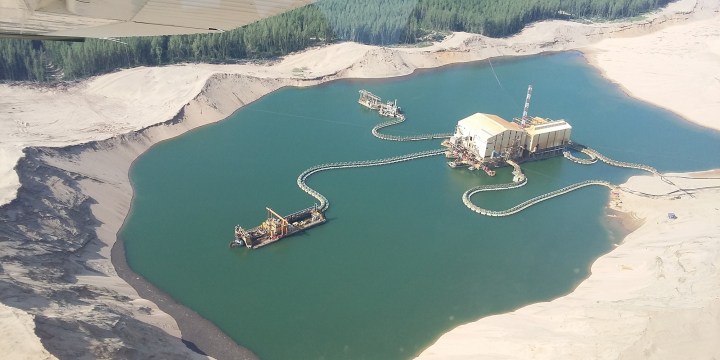
The mining and forestry industry are set for a head-to-head legal clash over Rio Tinto’s plan to prospect for titanium-heavy minerals on a massive swathe of land on the Zululand coast.
The 37,700-hectare block of land in question – currently occupied by extensive commercial timber plantations – stretches from Richards Bay northwards almost as far as the Mfolozi River and includes more than 100 “farm portions”.
Mondi South Africa, which owns or leases 35 farms in the affected area, fears that it could lose up to 25% of timber supplies for its pulp and paper mill in Richards Bay if the Rio Tinto-controlled Richards Bay Minerals (RBM) group were to find economically viable deposits of titanium-heavy minerals. They include zircon, ilmenite, leucoxene and rutile, which are used in a variety of products ranging from paint pigments to smartphones.
The new RBM mineral exploration plan, authorised by the Department of Mineral Resources and Energy (DMRE) on 9 March, is expected to reignite long-standing legal disputes over the property rights of landowners when minerals are discovered on private and communal land. The proposal also heightens concern over the large volumes of fresh water used in open-cast heavy minerals mining.
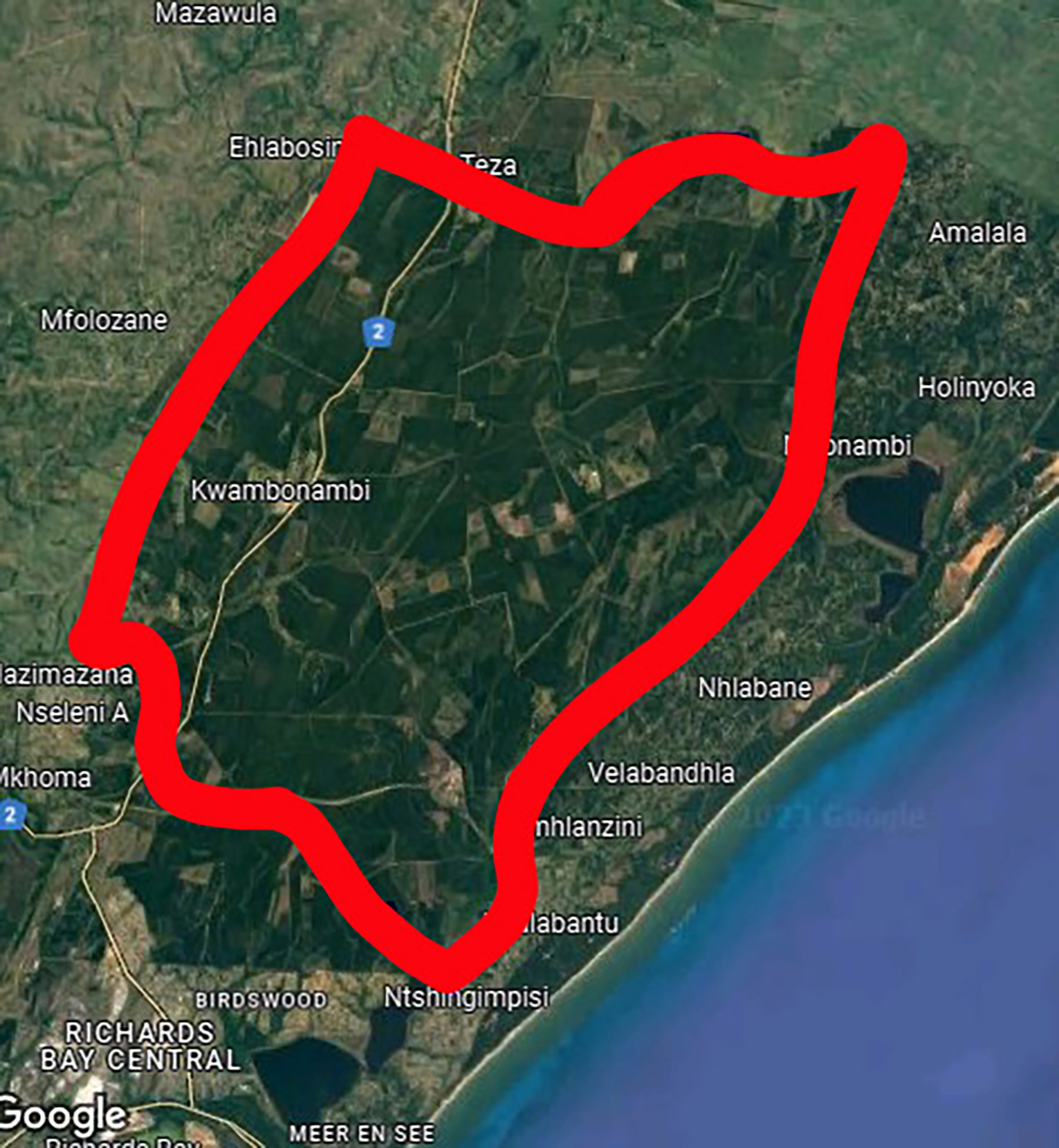
A map showing the 37,700-hectare RBM prospecting area north of Richards Bay. (Image: Google Maps)
Similar concerns are emerging over a separate application by the Tronox group, which is applying for new mining rights on predominantly commercial timber land stretching northwards from the town of Mtunzini to Richards Bay. Tronox hopes to consolidate mining rights for new mineral resources that would continue until mine closure in 2074.
The practice of mining trumping all other land uses is a relic of South Africa’s past and is in conflict with the current law of this country.
RBM and Tronox (along with Mondi and Foscor) have been ranked as the four most water-intensive industries in Richards Bay, collectively accounting for more than 90% of the area’s industrial water consumption in 2015.
For now, however, the dispute is likely to focus on the recent decision by the DMRE to grant “non-invasive” prospecting rights to RBM, despite objections by Mondi, Sappi, smaller timber companies and the Ezemvelo KZN Wildlife nature conservation agency.
Mondi, which did not respond to queries from Our Burning Planet on 23 March, is expected to lodge an appeal against the decision.
In a written objection prepared on Mondi’s behalf in 2022, Shepstone and Wylie attorney Ian Sampson noted that RBM had not obtained Mondi’s consent as the landowner before applying for prospecting and exploration rights.
Read more in Daily Maverick: Activists haul diamond-mining company to court to avert ‘moonscape’ fate for sensitive West Coast
While current mining law no longer requires landowner consent when minerals are discovered, Sampson argues that “the practice of mining trumping all other land uses is a relic of South Africa’s past and is in conflict with the current law of this country”.
Should the mining department ignore Mondi’s land rights north of Richards Bay, he said this could potentially contravene several constitutional rights – including section 25 (property); section 9 (equality before the law); section 22 (freedom of trade) and section 24 (environment).
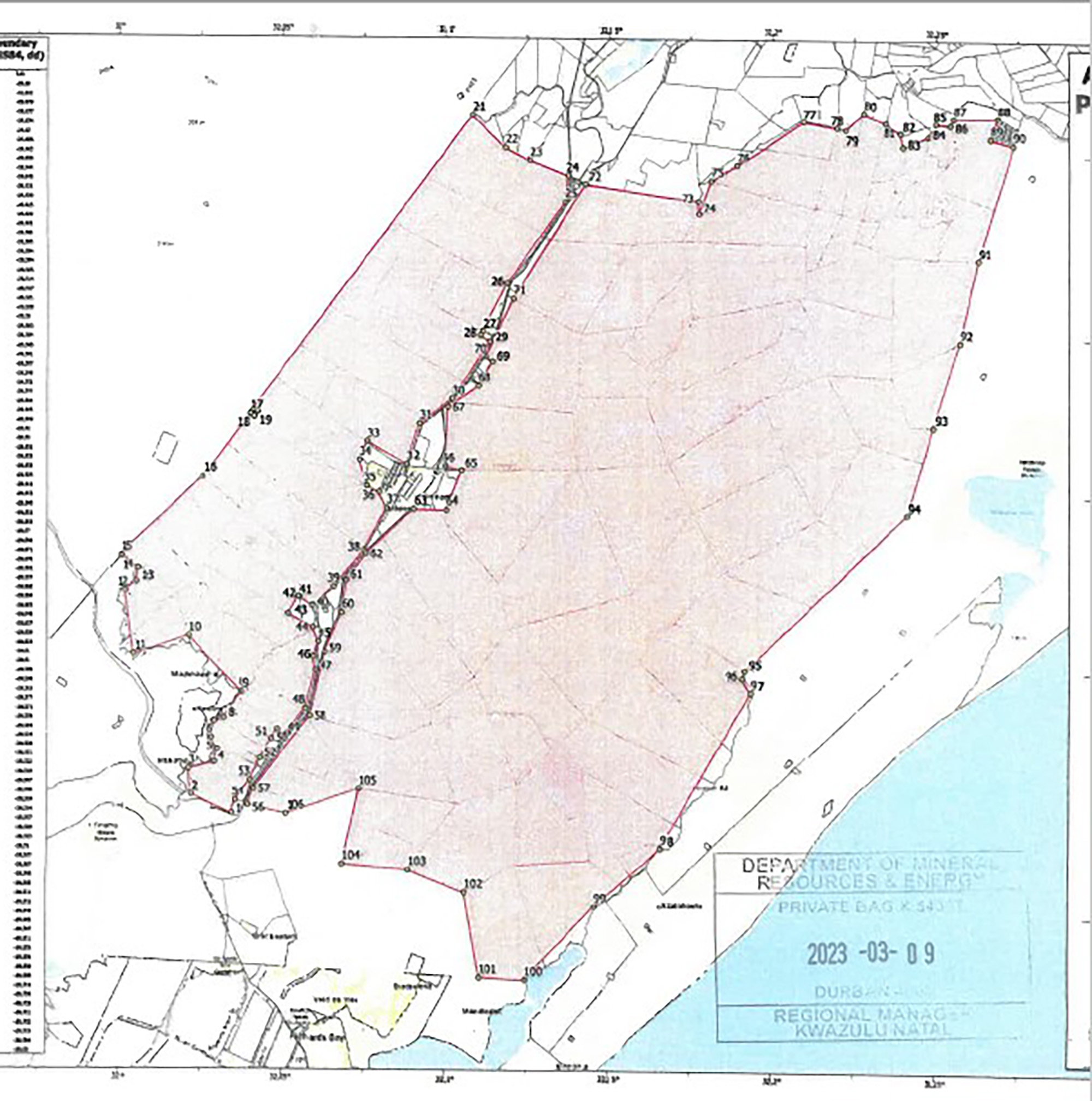
A map showing the 37,700-hectare RBM prospecting area north of Richards Bay. (Image: Supplied)
Sampson noted that an amendment to environmental laws in June 2021 made it compulsory for mining companies to obtain written consent from the landowner when applying for environmental authorisation.
But in March 2022, Environment Minister Barbara Creecy revoked this requirement, seemingly at the behest of the mining industry.
University of KwaZulu-Natal environmental law expert Professor Michael Kidd says Creecy’s “somewhat mysterious backtracking” on this issue meant that (for now) mining companies no longer need to obtain landowner consent when applying for environmental authorisation for prospecting or exploration rights.
A reduction in groundwater quality will also pose a serious health risk to the surrounding communities.
Kidd remarked that Creecy’s most recent decision on landowner consent was “not surprising, given that the supporters of mining in government (a significant force) would have regarded this legislative amendment as a further obstacle – potentially a very difficult one – to commencing mining operations”.
The ‘critical’ matter of water
In his submission to the DMRE, Sampson questioned whether the land and soil under dispute would remain viable for timber production in future if RBM was permitted to mine it.
He noted that mining companies still had to obtain landowner consent when applying for water use licences from the Department of Water and Sanitation and that “our clients (Mondi) will not provide consent for the water use licence application”.
Read more in Daily Maverick: Report raises alarm over mines’ pollution of rivers critical to Lesotho Highlands Water Project
“Water is a critical issue for our client’s business and is highly sensitive in the area,” said Sampson.
In a separate submission on behalf of Mondi, Green Door environmental consultant Phillipa Harrison noted that 35 of the farm properties targeted for RBM exploration are owned or leased by Mondi. There were also 139 boreholes within the prospecting area and another 428 within a 5km radius, indicating the significant reliance on groundwater in the area.
“Any negative impacts to the groundwater resulting from the prospecting activities and any future mining activities, will have a significant negative effect on the well-being and livelihoods of the surrounding communities.
“A reduction in groundwater quality will also pose a serious health risk to the surrounding communities.”
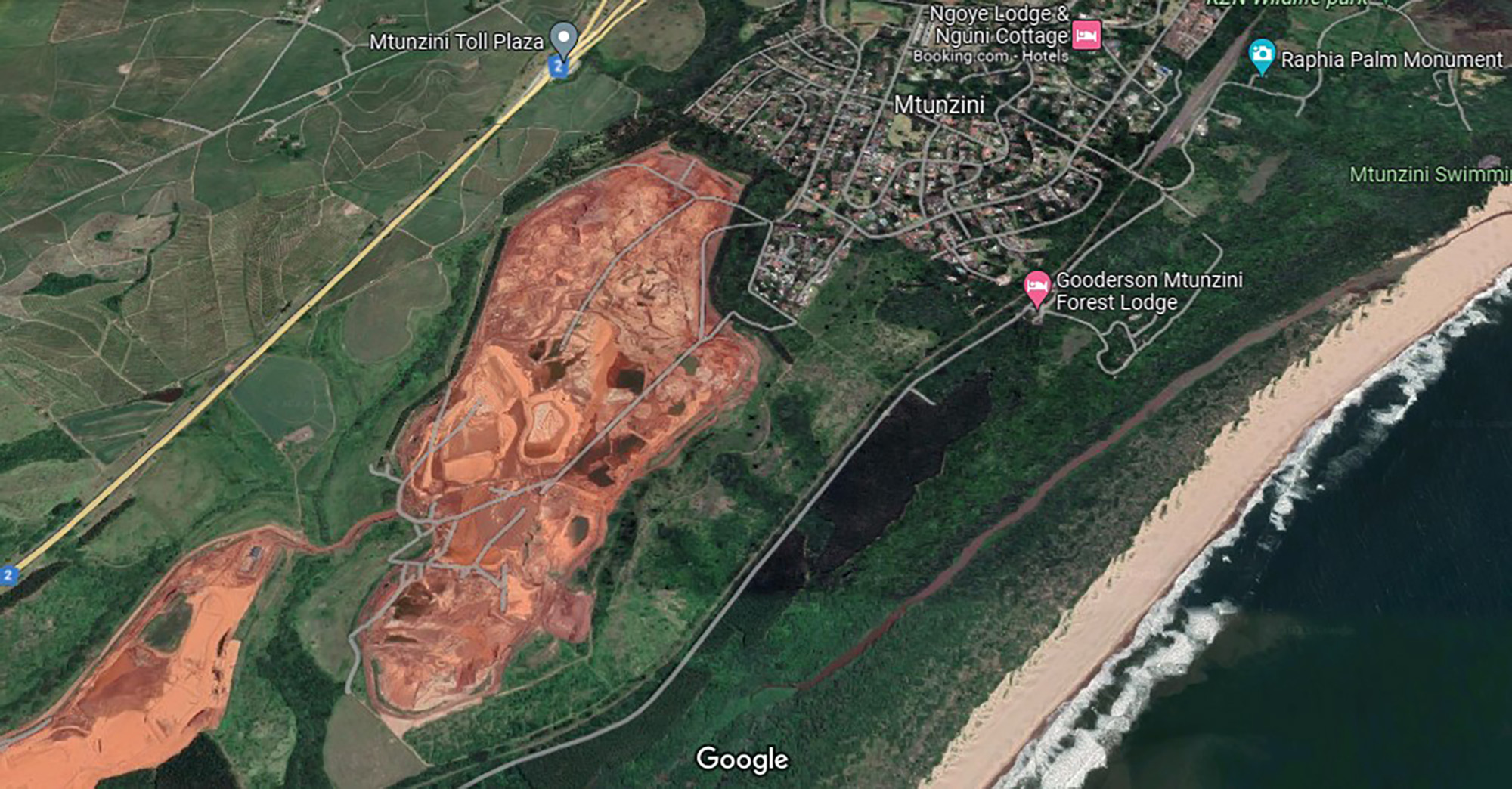
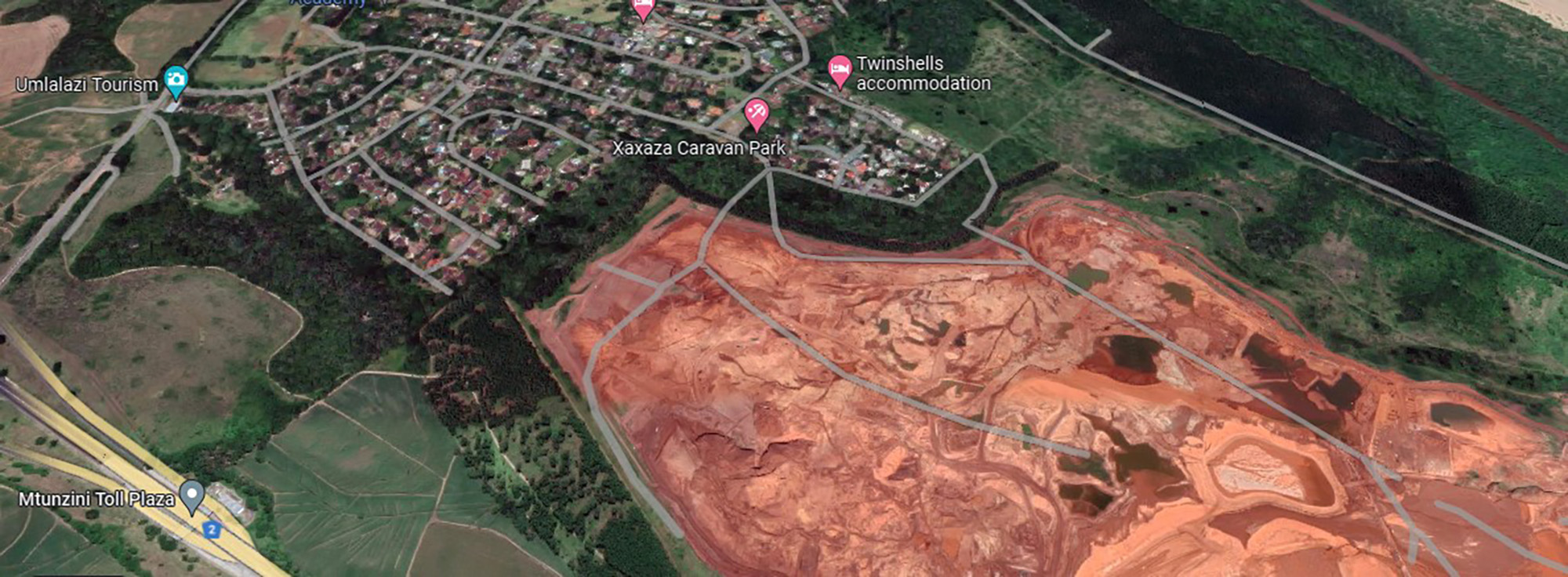
An aerial view of some of the open-cast Tronox mining pits next to the coastal town of Mtunzini. (Image: Google)
Harrison notes that the 37,770ha targeted for exploration were classified as a “closed catchment”, meaning that no further commercial forestry was allowed. If any of this land were to be mined by RBM in future, Mondi would not be able to replace the timber supply from the immediate vicinity.
“Should it be possible to replace the loss of planted area with landholdings in a different catchment, there will be additional and incremental costs of acquisition and establishment, as well as longer leads and therefore increased transport costs.
“The forestry operations on the (Mondi-) owned and leased landholdings located within and surrounding the prospecting area are essential to the sustainable supply of raw materials to the nearby Richards Bay Mill.”
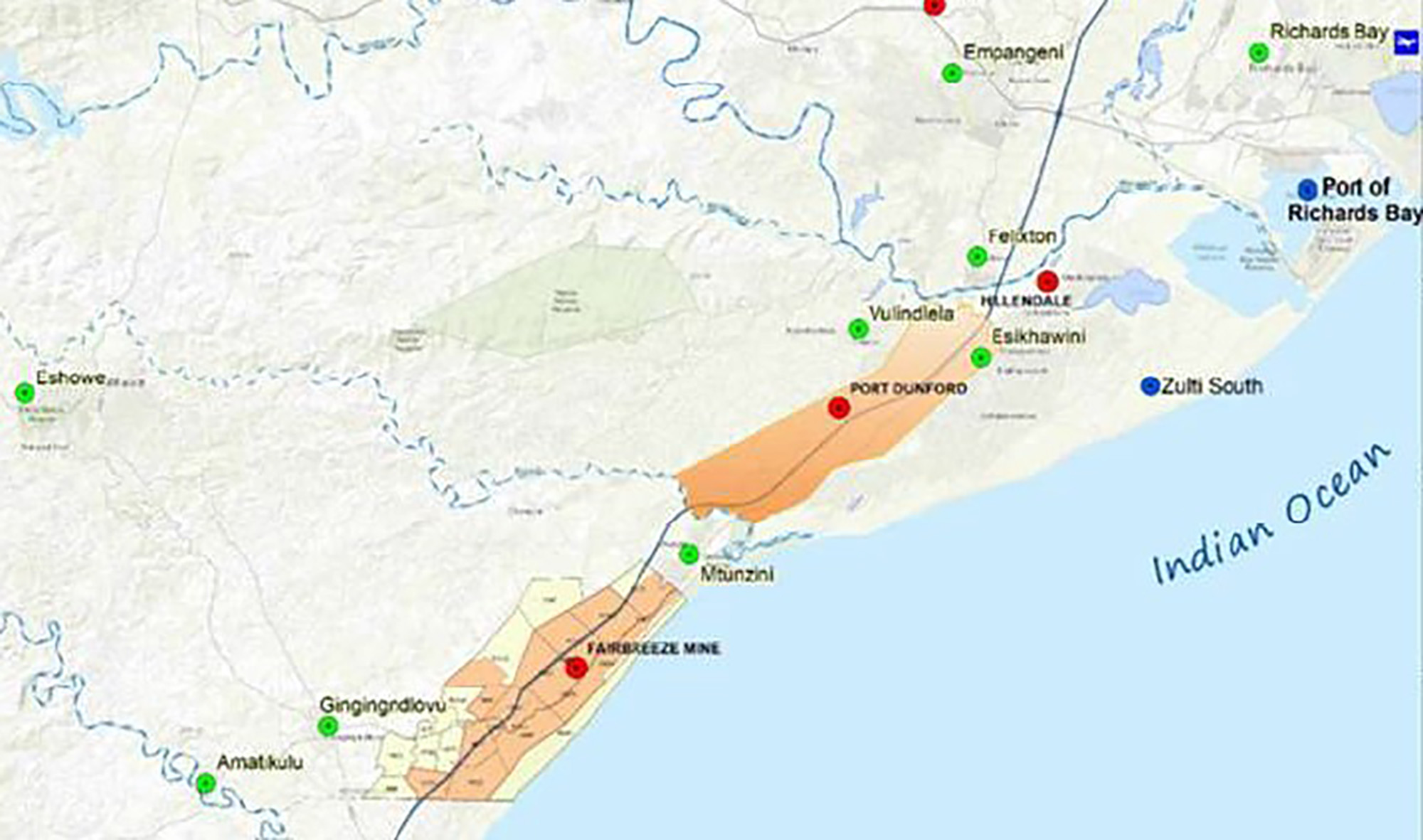
The current Tronox dune mining operations south of Mtunzini (bottom) and the new mining rights areas the company hopes to obtain north of the town. (Image: WSP draft scoping report)
Because the affected plantation area currently supplied nearly 25% of roundwood fibre supplies to Mondi’s Richards Bay mill, any reduction in timber supply due to mining could threaten the economic viability of this mill and lead to “severe financial losses” to Mondi.
Mondi therefore objected to the RBM prospecting rights “in the strongest possible capacity”, said Harrison, also noting that Mondi would invoke the right to appeal if the DMRE granted environmental authorisation to RBM.
Our Burning Planet sent several questions on 24 March to RBM, including queries about the company’s strategy to reduce water consumption. RBM spokesperson Zanele Zungu has not responded yet. DM/OBP



















 Become an Insider
Become an Insider
Wo you not show pictures of mining areas which have been rehabilitated? After 15 years natural forests or plantations, whatever the owner wants, are back. The minerals are out and the land is safe. Leave them in the sands and then in 25, 50, 100 years someone will grab it and not rehabilitate as RBM does. One does not have to go out of the country to find them, the thieves are right here, perhaps in Mpumalanga.